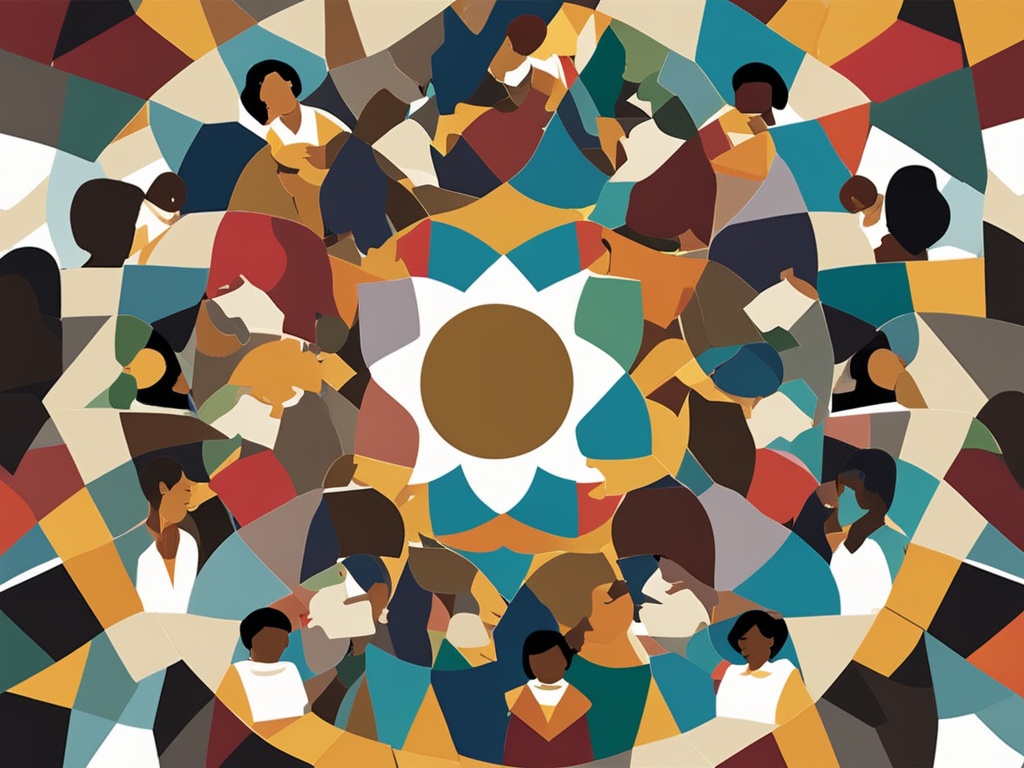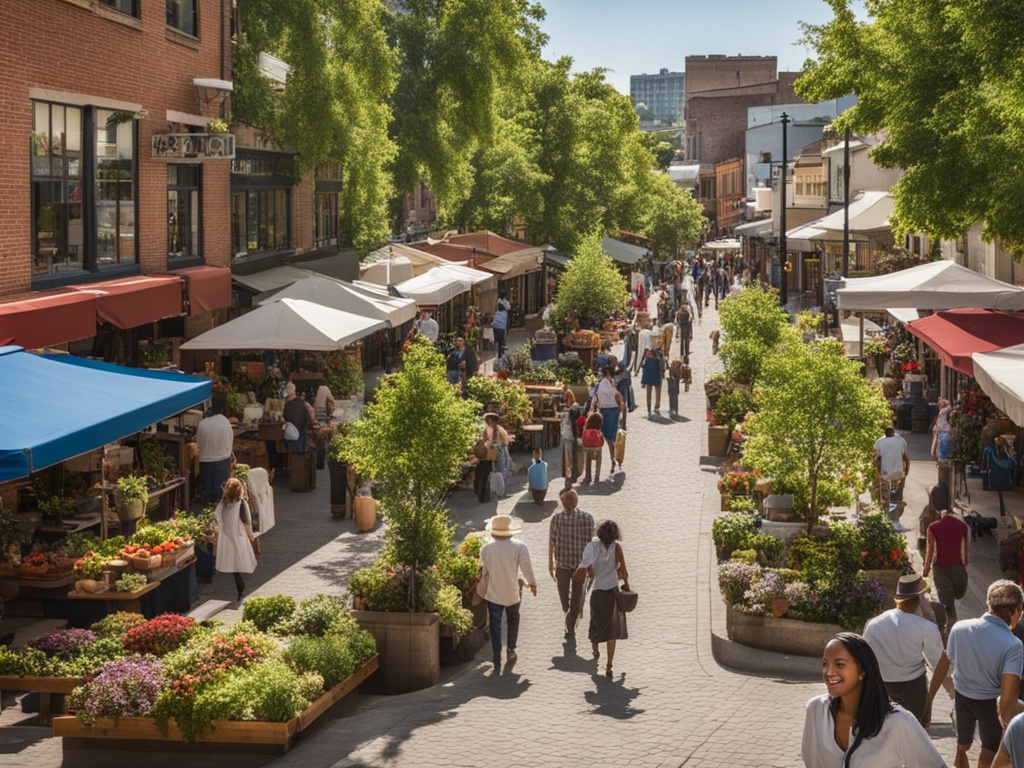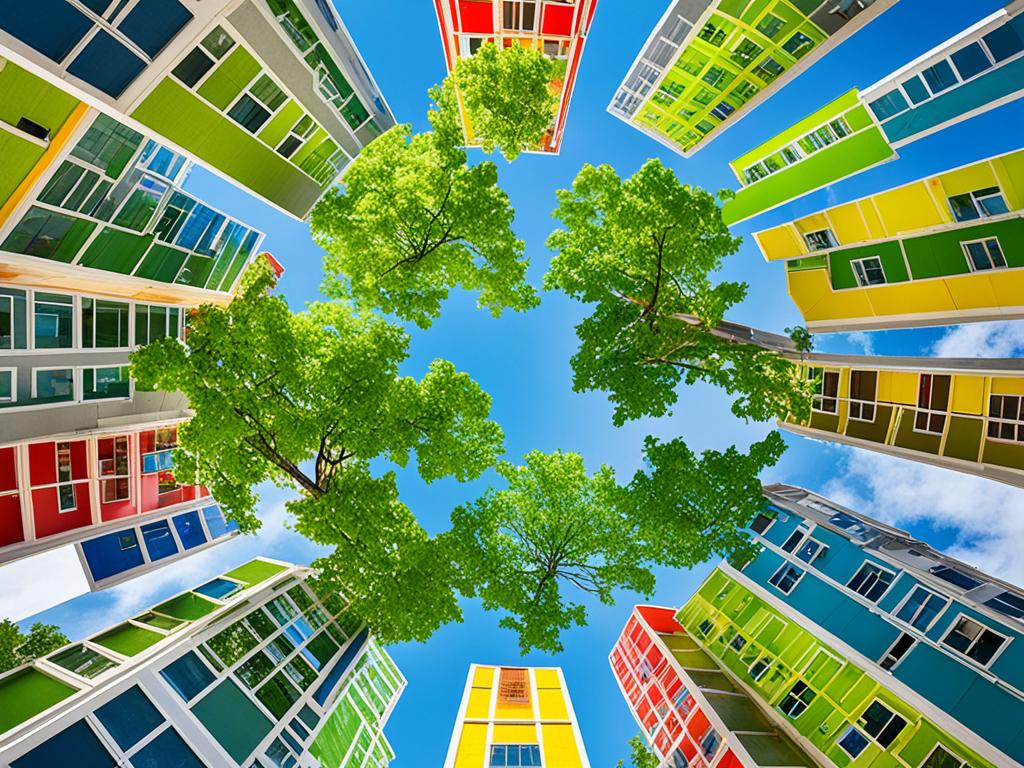Sustainable Communities Strategies are key in California’s big climate and air quality aims. They help with public health, fair access, and saving nature. Plus, they boost local business.
In 2008, California started the Sustainable Communities and Climate Protection Act (SB 375). This law asks 18 big city planning groups to make plans. These plans look at how to mix houses, transport, and land use. The goal? Cut greenhouse gas (GHG) levels, as set by the California Air Resources Board (CARB).
This planning happens in cycles. So far, each region has made its first step. Now, most are busy upgrading their strategies. They want to make their communities more sustainable.
Key Takeaways:
- Sustainable Communities Strategies help California advance climate, environmental, and community goals through integrated regional planning.
- SB 375 requires metropolitan planning organizations to develop SCS plans that reduce per capita greenhouse gas emissions by aligning transportation, housing, and land use decisions.
- The SCS planning process is iterative, with regions continuously updating their strategies to meet evolving targets and community needs.
- Sustainable Communities Strategies promote a holistic approach to community development, balancing economic, environmental, and social objectives.
- Successful implementation of Sustainable Communities Strategies relies on collaboration between local governments, transportation agencies, and community stakeholders.
What is Sustainable Community Development?
Sustainable community development looks at the whole community to make it better. It deals with problems in the environment, economy, and society. The Maryland Department of Housing and Community Development’s program gives resources for community empowerment, environmental conservation, economic revitalization, social inclusion, and more. This helps make communities stronger and more equal.
Fostering Healthy Local Economies
The Sustainable Communities program helps improve places people live and work in. It helps make them stronger. This includes making life better for local businesses and entrepreneurs, making the place attractive for investment and tourism, and making sure people have economic security.
Protecting Historical and Cultural Resources
The program is big on making sure important parts of a community’s history and culture stay safe. It does this by putting efforts into historic preservation. This is important for a sustainable future.
Promoting Mixed Land Use
Building areas with different uses like homes, stores, and parks is part of this program. This mix makes places better to live in. It means walking and taking public transport is easier. Plus, it cuts down on how much we drive.
Providing Affordable Housing and Employment Options
The program works on making sure everyone has a place to live and work. It focuses on affordable housing and jobs. This helps make the community fair and happy for everyone.
Conserving Natural Resources and Encouraging Sustainable Practices
This program is big on taking care of the earth. It looks to save natural resources and animals’ homes. It also wants to use more renewable energy and plan for climate changes. This makes the community and nature stronger.
Sustainable Communities Strategies and Climate Goals
California’s Sustainable Communities Strategies (SCS) are key in fighting climate change. They help the state reach its emission reduction goals. These goals come from the California Air Resources Board (CARB)’s 2017 Scoping Plan. This plan is in response to SB 32, wanting to cut emissions by 40 percent from 1990 levels by 2030.
In the transportation field, plans focus on using low-carbon fuels and cleaner vehicles. They also promote areas where people can live, work, and play close together. This lessens the need to travel long distances.
Reducing Greenhouse Gas Emissions
SCSs, as part of SB 375, combine how we travel, where we live, and how we build. They aim to lower the amount of emissions per person. One big way they do this is by reducing how much we drive.
The plans aim to cut emissions from cars by 19 percent across the state by 2035. They also want to see a 25 percent lower emission rate from cars by 2035 compared to 2005.
Curbing Vehicle Miles Traveled
SCS planning is ongoing in California. All regions have finished at least one plan, and many are working on their second. These plans map out how communities can grow thoughtfully, saving nature and farmland. They focus on using land where buildings are already and on making public transport better. Their main goal is to stop the increase in how much we drive.
Promoting Walkability and Transit Accessibility
SCSs also work on making it easier and safer to walk or bike. They plan for different types of homes close to where people work. This not only cuts emissions but also makes communities nicer to live in. It helps improve health, boosts the economy, and gives people more ways to get around.
Key Aspects of Sustainable Communities Strategies
In California, regions are working on Sustainable Communities Strategies (SCS) plans. These plans are creating a vision where everyone works together for a better future. They focus on making communities stronger by empowering people. They also work on protecting the environment and making sure everyone has access to what they need.
Focusing Growth in Existing Urban Areas
SCS plans choose to grow in places that are already built up. This way, people can find jobs and homes close to each other. They can use public transport easily and enjoy nature. By doing this, we use less land and protect the environment.
Utilizing Infill Opportunities
Using available space in cities for development helps avoid building over green areas. It’s good for the environment and helps communities stay strong. It means we can protect natural habitats while still having places to live and work close together.
Investing in Public Transportation
SCS plans want to make public transport better for everyone. They focus on adding more routes and making buses and trains come more often. Good public transport means fewer cars on the road. This helps fight air pollution and makes getting around easier for people.
Improving Active Transportation Infrastructure
SCS plans also want to make it safer and easier to walk or bike. They add bike lanes and make streets more friendly for pedestrians. This encourages people to use their bikes or walk more. It’s good for the community and the planet.
Implementing Transportation Demand Management Programs
SCS plans include ways to share rides and manage parking. These ideas help lower the number of cars on the road. They are important for keeping our air clean and making sure people have sustainable ways to get around.
Strategies for Sustainable Community Development
The Conservation Fund helps save land and fight climate change. It also helps make communities better. These communities can be in cities or the countryside and are good for everyone. The Fund works to make sure these places are healthy and inviting.
It does this by encouraging strong development in cities. It also helps the countryside with natural resources. Additionally, it supports local food and farming that’s good for people and the planet.
The Fund works on saving the environment, bringing back jobs, and including everyone. It helps communities become strong by working together and looking to the future. They help make plans that are good for the environment and fair for all.
| Key Sustainable Community Initiatives | Outcomes |
|---|---|
| Inspiring resilient and equitable urban development | Promotes community empowerment, social inclusion, and economic revitalization in cities |
| Supporting rural investment and natural resource-based economies | Fosters environmental conservation, economic diversification, and community prosperity in rural areas |
| Promoting healthy and sustainable local food and farming | Enhances food security, environmental sustainability, and community well-being |
The Fund’s work is about making communities that are strong, fair, and full of life. They want every part of the community to do well. This means economic success, happiness, and a clean world for everyone.
Community Engagement and Stakeholder Collaboration
Sustainable community development focuses on two big things: community engagement and stakeholder collaboration. Creating plans for Sustainable Communities involves teamwork. Cities, counties, and transport agencies join hands. They make decisions about land use, build infrastructure, plan transport, and work on the environment. This teamwork leads to a better climate and community benefits.
Policies for SCS aren’t a must, but many communities want to be more sustainable. Also, there are perks for areas that meet these goals. Getting the community involved brings folks together. It makes services better and lifts quality of life.
Involving Local Residents and Organizations
Successful community engagement means getting locals and groups involved. Their input helps shape sustainable development plans. The plans better meet what the community wants. This is what Asset-Based Community Development (ABCD) is all about. It helps communities find and use their own assets and resources.
Fostering Public-Private Partnerships
Building public-private partnerships is key to sustainable community development. These partnerships bring together different groups. They include government, businesses, nonprofits, and community folks. Working together, they can do more to tackle big societal issues. Together, they make a real and lasting sustainable change. Such partnerships also build trust and credibility among the parties. This trust is crucial for the future success of the work they do together.

Environmental Conservation and Resilience
The Conservation Fund works hard to help countryside areas and their economies. They support local food and farming that’s good for people and the environment. They are also working on plans to adapt to climate change.
Preserving Natural Resources and Habitats
The Fund is making sure important natural areas are not lost. They bought 30 acres for the Garlic eScape project to support farming that keeps the land safe. They also got a 90-acre farm in Georgia, making more fresh, local food available.
Promoting Renewable Energy Initiatives
While saving nature, the Fund also pushes for using renewable energy. They help communities switch to clean energy like solar and wind power. This cuts down on pollution and makes energy more steady in these places.
Implementing Climate Adaptation Strategies
The Fund helps places get ready for climate changes in ways that fit their situations. For example, in Michigan’s Saginaw Bay Watershed, they’re working on plans to use natural resources wisely. This effort is massive, covering over 7,000 miles of rivers and streams.
Economic Revitalization and Job Creation
The Conservation Fund helps rural places and their economies grow. It tackles investing in local resources and food. It also works on making cities more resilient and fair. These actions boost businesses, attract investors, and boost tourism. It’s all part of their plan to revive economies.
Supporting Local Businesses and Entrepreneurs
The Fund knows local businesses are key in growing communities. It supports them with tools, advice, and development help. This empowers local people to start businesses. It brings more jobs, goods, and services to cities and the countryside.
Attracting Investment and Promoting Tourism
They also help communities get outside money and grow tourism. By highlighting what makes a place special, they get targeted investments and attract mindful tourists. Through teaming up with different groups and using disaster recovery for growth, they’re creating better jobs and revitalizing areas.

Social Inclusion and Equity
The Conservation Fund cares deeply about making communities better. They work to make sure everyone has a fair chance. This means making sure people have what they need, like fair access to stuff, places to live, and fixing issues that harm the environment.
Providing Equitable Access to Resources
Not everyone gets the same help. This includes things like technology, places to go after school, ways to get around, and programs to save energy. The Fund works to make these things equal for everyone. Their goal is to help all people in a community be healthy and happy.
Promoting Affordable Housing
Many cities face a big problem with not enough affordable places to live. This is getting worse as more people move to cities. The Conservation Fund is working hard to help build homes that everyone can afford. They believe having a safe place to live is key to a good life.
Addressing Environmental Justice Concerns
Communities that are already struggling are hit hard by climate change. The Fund is working on ways to protect the environment, use more clean energy, and get ready for climate changes. They want everyone to benefit from a better environment, no matter their background.
Capacity Building and Resource Allocation
The Sustainable Communities program gives tools to help communities grow and stay strong. It’s all about capacity building and smartly sharing resources. This way, communities can stand on their own and improve for the long term.
Investing in Community Infrastructure
The program focuses on making communities more resilient. It helps with things like better ways to get around, clean energy, and making sure everyone can reach basic needs fairly. This makes life better for everyone in the community.
Providing Technical Assistance and Training
The program teaches communities new skills and provides help when needed. This way, they can put in place plans that help meet important goals. These goals are about making life better in every way for the people living there.
Securing Funding and Incentives
The program also works to get communities money and support. It helps them find ways to pay for important projects that benefit everyone. This might include things like making neighborhoods nicer, helping with home costs, and other projects that give power back to the community.

| Funding Source | FY 2022 Funds | FY 2023 Funds | Total Funding |
|---|---|---|---|
| Section 4 Capacity Building for Community Development and Affordable Housing | $41,000,000 | $42,000,000 | $83,000,000 |
| Rural Capacity Building Activities | $5,000,000 | $5,000,000 | $10,000,000 |
| Targeted Capacity Building for Native Hawaiian, American Indian, and Alaska Native Communities | – | $1,000,000 | $1,000,000 |
Monitoring and Evaluation
The Sustainable Communities program asks cities to keep watch on their strategies’ success. This means they look at if they’re cutting down on greenhouse gases and making life better. They check on health benefits, better ways to get around, where people live, saving nature, and fairness. By keeping an eye on things, they make sure their plans are doing what they should.
Many groups like government bodies, non-profits, and big companies have smart ways to watch and learn from their work. Resonance, for example, is big on proving what works for big changes (E4T). They check how well projects are doing all the time and they tweak them to work better. Different ways are used to see if strategies are hitting their targets. This helps make sure these big efforts are actually helping out. Knowing what’s working helps them make smarter choices as they move forward.
Projects that make a real difference often change their ways based on what their data shows. For example, a study in Peru was done to help their government check if their plans were really working. Another study looked into how well certain environmental practices were being followed in the Amazon. And there was a check on a plan to fight human trafficking in the Amazon too. In the US, USAID has its own system to keep an eye on how well their plans are going. They’re working on updating how they gather information and learn from it.
Source Links
- https://dhcd.maryland.gov/Communities/pages/dn/default.aspx
- https://ww2.arb.ca.gov/our-work/programs/sustainable-communities-program/what-are-sustainable-communities-strategies
- https://walterschindler.com/leadership/6-helpful-community-engagement-strategies-for-sustainable-habits/
- https://sustain.org/about/what-is-a-sustainable-community/
- https://www.conservationfund.org/our-work/sustainable-community-development
- https://www.universalclass.com/articles/business/the-meaning-of-sustainability-in-community-development.htm
- https://www.worldbank.org/en/topic/sustainable-communities
- https://wesolve.app/what-is-community-engagement/
- https://aese.psu.edu/research/centers/cecd/engagement-toolbox/engagement/what-is-community-engagement
- https://www.linkedin.com/pulse/environmental-conservation-sustainability-edwin-cornelius
- https://www.hudexchange.info/programs/cdbg-dr/economic-revitalization-guide/introduction/
- https://communityactionpartnership.com/community-economic-development-ced/
- https://icma.org/articles/article/three-strategies-advancing-social-equity-and-increasing-community-sustainability
- https://www.icf.com/insights/social-programs/gender-equality-social-inclusion-sustainable-development
- https://www.linkedin.com/pulse/promoting-social-equity-inclusion-sustainable-urban-teddy-eliud-om7yf
- https://www.hud.gov/program_offices/spm/gmomgmt/grantsinfo/fundingopps/fy23_section4
- https://sdgresources.relx.com/capacity-building
- https://www.resonanceglobal.com/blog/what-is-monitoring-evaluation-and-learning-mel
- https://www.usaid.gov/peru/monitoring-evaluation-and-learning-sustainability
- https://villageearth.org/the-role-of-participatory-monitoring-and-evaluation-in-community-based-development/


